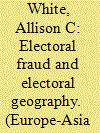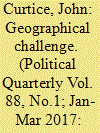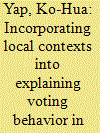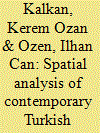|
|
|
Sort Order |
|
|
|
Items / Page
|
|
|
|
|
|
|
| Srl | Item |
| 1 |
ID:
145630


|
|
|
|
|
| Summary/Abstract |
This article aims to analyze the dynamics of the party system in Turkey by focusing on the AKP and construct an aggregate-level analysis of the electoral environment it operates in using regression models (1950–2011). Findings show strong patterns of continuity in the electoral geography of Turkey since the 1970s, mapping electoral strongholds of center-right, ultra-nationalist and pro-Islamist parties compared to those of the AKP. As of 2015, the AKP seems to have achieved a great deal of stabilization electorally and there is now handful of data that can identify and answer some of the questions related to the AKP, especially regarding its ideology, origins, electoral strength and appeal.
|
|
|
|
|
|
|
|
|
|
|
|
|
|
|
|
| 2 |
ID:
110633


|
|
|
|
|
| Publication |
2011.
|
| Summary/Abstract |
The purpose of this article is to examine the potential impact of Hispanics on the electoral geography of the southern United States after the 2010 decennial census. Hispanics are the largest and fastest-growing minority group in the United States today. In addition to traditional Hispanic destinations such as Florida and Texas, many of the areas experiencing the most rapid growth in Hispanic population are southern states such as Georgia, North Carolina, and Virginia. Geographic information systems are used to determine where majority-minority and influential districts are likely to emerge in southern states. We argue that although the Latino population has increased significantly over the past decade, the proportion of Latinos living in southern states remains relatively low in comparison to the general population. Therefore, no new majority-minority or influence districts will emerge in Louisiana, Mississippi, or Tennessee. Majority-minority and influence districts are likely to emerge in Arkansas, Georgia, North Carolina, South Carolina, and Virginia at the state and local levels, but not at the U.S. congressional level. Texas and Florida are the only southern states where new majority-minority and influence districts are likely to emerge at the U.S., state, and local levels after the 2010 decennial census.
|
|
|
|
|
|
|
|
|
|
|
|
|
|
|
|
| 3 |
ID:
147950


|
|
|
|
|
| Summary/Abstract |
Despite United Russia’s (Edinaya Rossiya—UR) dominance in repeated Russian legislative elections, the correlates of the party’s electoral support remain noticeably understudied beyond the influence of electoral manipulation. I pinpoint the specific contours of UR’s strongholds in the two most recent parliamentary elections in Russia—2007 and 2011—focusing on raion- and regional-level correlates of the vote using an original dataset. UR has been undergirded by geographically concentrated ethnic minorities and the countryside, and these patterns of support have persisted even in the absence of fraud, suggesting that the dominant party’s electoral windfalls cannot be attributed solely to electoral malfeasance.
|
|
|
|
|
|
|
|
|
|
|
|
|
|
|
|
| 4 |
ID:
152549


|
|
|
|
|
| Summary/Abstract |
Labour won fewer seats in 2015 than in 2010, even though its share of the vote increased. The decline in representation was occasioned by three features of the electoral geography of the 2015 contest—a collapse in Labour support in Scotland, a particularly strong Conservative advance in marginal seats and the fact that in England and Wales Labour's vote rose most strongly in seats that the party already held. As a result, Labour's vote became markedly less efficiently distributed than that of the Conservatives—a development that could make it very difficult for the party to win an overall majority at the next election. Meanwhile, the redrawing of constituency boundaries that is currently in train will make winning a majority even more difficult. However, the next election could well produce a hung parliament, and the party should be prepared for that eventuality.
|
|
|
|
|
|
|
|
|
|
|
|
|
|
|
|
| 5 |
ID:
107694


|
|
|
|
|
| Publication |
2011.
|
| Summary/Abstract |
Most electoral studies have "atomized" voters, detaching them from their local contexts. To provide evidence that local context does matter in voting behavior in Taiwan, this study will combine individual and ecological data relating to the Taiwan presidential election of 2004. The results show that both local ethnic composition and the economic situation of a township ran influence the voting behavior of residents. First, people who identify themselves as Taiwanese are more likely to vote DPP, while the higher the percentage of Hohlo there is in a township, the more likely its residents are to identify themselves as Taiwanese, and conversely, the higher the percentage of mainlanders, the less likely residents are to identify themselves as Taiwanese. Second, residents educated to senior high school-level or above are more likely to vote DPP in more affluent townships, while those educated to junior high school-level or below are more likely to vote DPP in more deprived townships. These findings suggest that similar people vote differently in different places.
|
|
|
|
|
|
|
|
|
|
|
|
|
|
|
|
| 6 |
ID:
039410


|
|
|
|
|
| Publication |
London, Methuen and Co Ltd, 1972.
|
| Description |
124p.Hbk
|
| Standard Number |
416070000
|
|
|
|
|
|
|
|
|
|
|
|
Copies: C:1/I:0,R:0,Q:0
Circulation
| Accession# | Call# | Current Location | Status | Policy | Location |
| 008917 | 910.32/PRE 008917 | Main | On Shelf | General | |
|
|
|
|
| 7 |
ID:
152455


|
|
|
|
|
| Summary/Abstract |
This study offers a comprehensive approach to spatial analysis of parliamentary elections in Turkey since 2002. Using advanced spatial models, we find that electoral competitiveness and concentration mostly stabilized in the Western subprovinces whereas they are still in flux in the Eastern and Southern regions. There is an increasing level of geographically dependent concentration and competitiveness in recent elections, particularly in the 2015 elections (June and November). Our analyses also show that while the ruling AKP party has become the party of all regions, its competitors (CHP, MHP, and HDP) exhibit a narrowing geographical appeal.
|
|
|
|
|
|
|
|
|
|
|
|
|
|
|
|
|
|
|
|
|